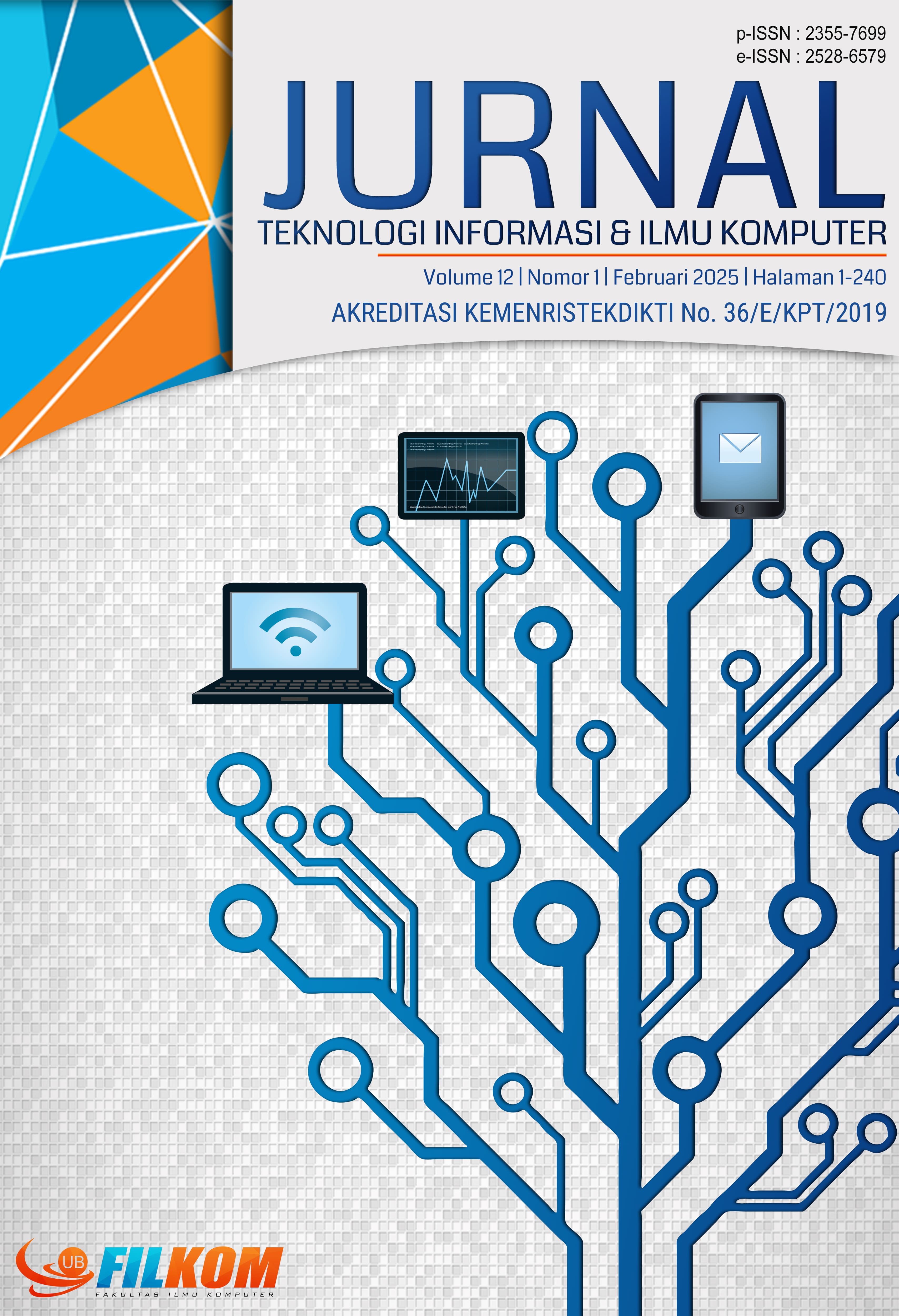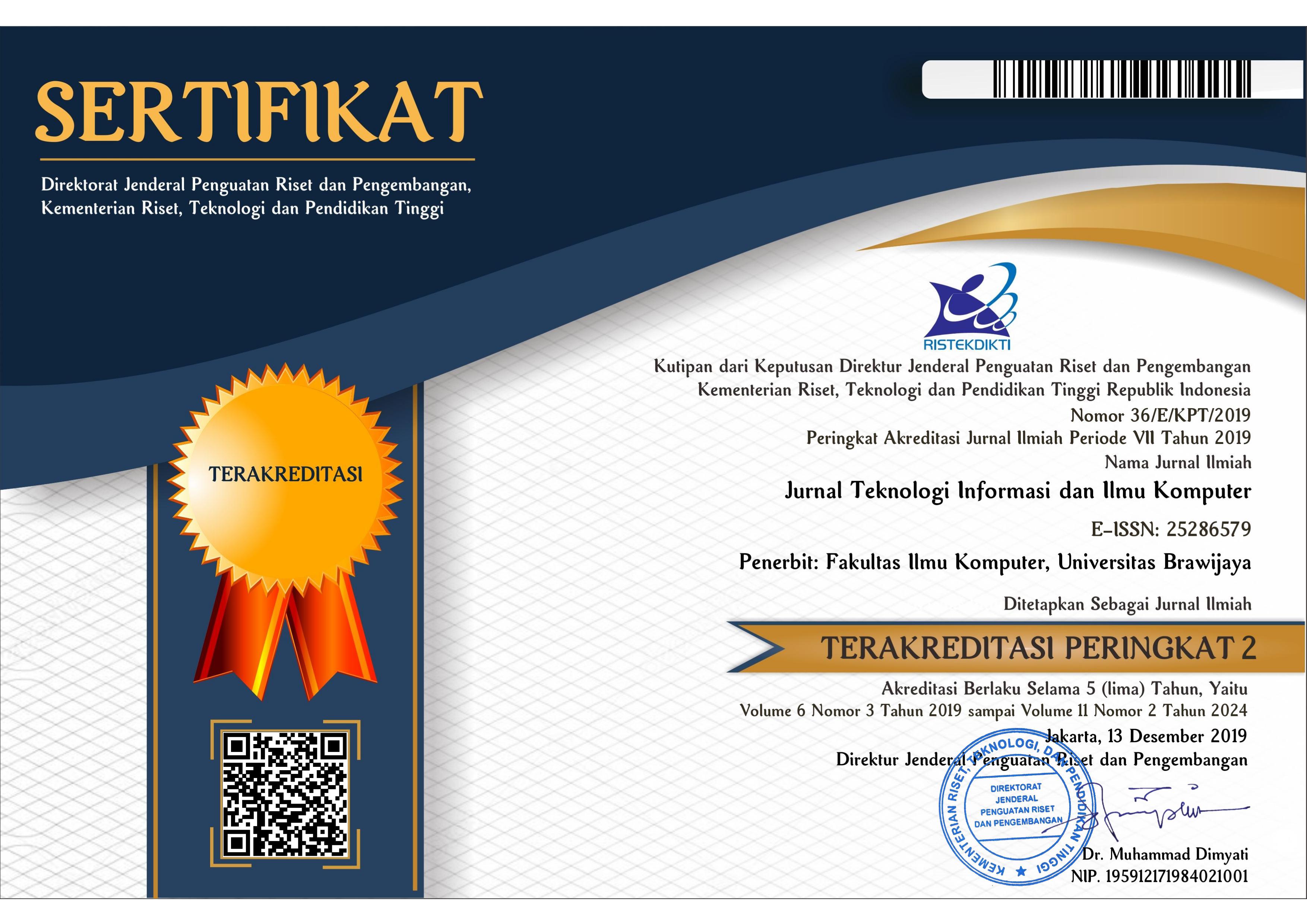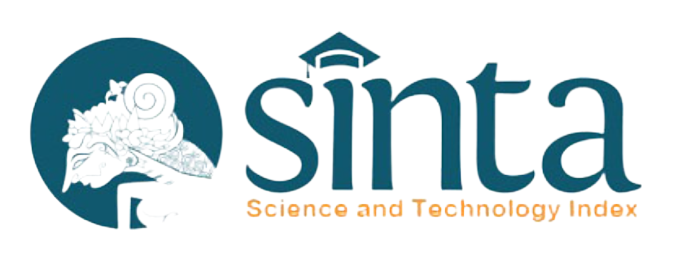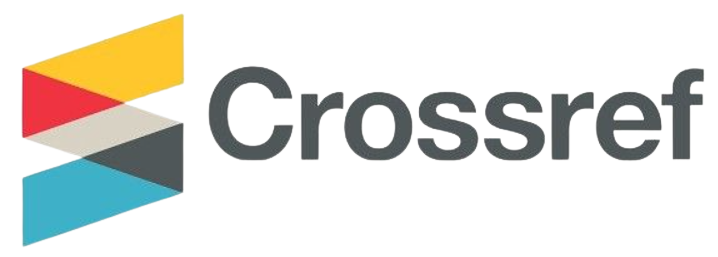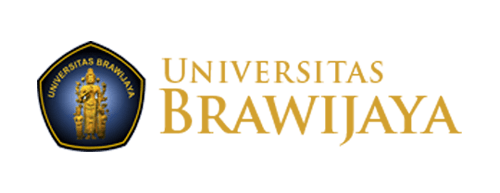Komparasi MobileNETV2 dengan Kustomisasi Transfer Learning dan Hyperparameter untuk Identifikasi Tumor Otak
DOI:
https://doi.org/10.25126/jtiik.2025129582Kata Kunci:
Transfer Learning MobileNetV2, Adam Optimizer, SGD Optimizer, Brain Tumour, Magnetic Resonance ImagingAbstrak
Tumor otak disebabkan dengan pertumbuhan sel otak yang abnormal pada jaringan otak yang menyebabkan kematian bagi pria dan wanita. Identifikasi tumor otak umumnya dilakukan dengan metode biopsi oleh dokter selama 10 hingga 15 hari. Namun, pendekatan modern diperlukan untuk menekan waktu dalam identifikasi tumor otak dengan teknologi deep learning. Dalam penelitian ini, menggunakan 4 kategori tumor otak yaitu glioma, meningioma, notumor, dan pituitary dengan akumulasi citra data sebanyak 20.000 data dan pembagian data meliputi 75% untuk train data, 15% untuk validation data, dan 10% untuk testing data. Penelitian ini bertujuan untuk membandingkan performa dari Adam dan Stochastic Gradient Descent Optimizer, dan model arsitektur transfer learning MobileNetV2 dan MobileNetV2 dalam identifikasi tumor otak. Penelitian ini menggunakan metode komparatif dengan metode evaluasi menggunakan confusion matrix. Comparative analysis dilakukan dengan membandingkan 4 skenario meliputi skenario 1 yaitu menggunakan Adam optimizer dan transfer learning, skenario 2 yaitu menggunakan SGD optimizer dan transfer learning, skenario 3 yaitu menggunakan Adam optimizer dan tanpa transfer learning, serta skenario 4 yaitu menggunakan SGD optimizer dan tanpa transfer learning. Hasil penelitian menunjukkan bahwa skenario 1 dengan penggunaan Adam optimizer dan model transfer learning MobileNetV2 memperoleh accuracy sebesar 98%, precision sebesar 98%, recall sebesar 97,75%, dan f1-score sebesar 97,75% yang merupakan hasil model terbaik, Temuan ini mengindikasikan bahwa peran transfer learning sangat berpengaruh baik pada performa model dan diharapkan dapat memberikan wawasan lebih mendalam terkait model arsitektur yang paling akurat untuk identifikasi tumor otak serta menawarkan fondasi untuk pengembangan aplikasi berbasis Magnetic Resonance Imaging dalam citra medis.
Abstract
Brain tumors are caused by the abnormal growth of brain cells in brain tissue, leading to death for both men and women. Typically, brain tumor identification is performed through a biopsy by doctors, taking 10 to 15 days. However, a modern approach is needed to reduce the time for brain tumor identification using deep learning technology. This study uses four categories of brain tumors: glioma, meningioma, no tumor, and pituitary tumor, with a dataset of 20,000 images. The data is divided into 75% for training, 15% for validation, and 10% for testing. The purpose of this study is to compare the performance of the Adam and Stochastic Gradient Descent (SGD) optimizers, as well as the MobileNetV2 and MobileNetV2 transfer learning architecture models in brain tumor identification. A comparative method is used, with evaluation through a confusion matrix. The analysis compares four scenarios: Scenario 1 using the Adam optimizer and transfer learning, Scenario 2 using the SGD optimizer and transfer learning, Scenario 3 using the Adam optimizer with no transfer learning, and Scenario 4 using the SGD optimizer with no transfer learning. The results show that Scenario 1, using the Adam optimizer and MobileNetV2 transfer learning, achieved the highest performance with 98% accuracy, 98% precision, 97.75% recall, and 97.75% F1-score. This finding highlights the significant impact of transfer learning on model performance, providing valuable insights into the most accurate architecture for brain tumor identification, and offers a foundation for developing Magnetic Resonance Imaging-based medical image applications.
Downloads
Referensi
AHMAD, S. and CHOUDHURY, P.K., 2022. On the Performance of Deep Transfer Learning Networks for Brain Tumor Detection Using MR Images. IEEE Access, 10, pp.59099–59114. https://doi.org/10.1109/ACCESS.2022.3179376.
ALMASLUKH, B., 2021. A Lightweight Deep Learning-Based Pneumonia Detection Approach for Energy-Efficient Medical Systems. Wireless Communications and Mobile Computing, pp.1–14. https://doi.org/10.1155/2021/5556635.
AMOU, M.A., XIA, K., KAMHI, S. & MOUHAFID, M., 2022. A Novel MRI Diagnosis Method for Brain Tumor Classification Based on CNN and Bayesian Optimization. Healthcare (Switzerland), 10. https://doi.org/10.3390/healthcare10030494
ANDRE, R., WAHYU, B. & PURBANINGTYAS, R., 2021. Klasifikasi Tumor Otak Menggunakan Convolutional Neural Network dengan Arsitektur EfficientNet-B3. [online] Available at: <https://jurnal.umj.ac.id/index.php/just-it/index>.
ARSYAD, N.P., WULANNINGRUM, R. and SETIAWAN, A.B., 2024. Implementasi Convolutional Neural Network Pada Deteksi Tumor Otak. [online] Agustus, Online. Available at: <https://proceeding.unpkediri.ac.id/index.php/inotek/> [Accessed 30 November 2024].
ARYA, A.D., VERMA, S.S., CHAKARABARTI, P., CHAKRABARTI, T., ELNGAR, A.A., KAMALI, A.M. and NAMI, M., 2023. A Systematic Review on Machine Learning and Deep Learning Techniques in the Effective Diagnosis of Alzheimer’s Disease. Brain Informatics, pp.1–15. https://doi.org/10.1186/s40708-023-00195-7.
ASIF, S., YI, W., AIN, Q.U., HOU, J., YI, T. and SI, J., 2022. Improving Effectiveness of Different Deep Transfer Learning-Based Models for Detecting Brain Tumors From MR Images. IEEE Access, 10, pp.34716–34730. https://doi.org/10.1109/ACCESS.2022.3153306.
BEIKMOHAMMADI, A. and FAEZ, K., 2018. Leaf Classification for Plant Recognition with Deep Transfer Learning. In: Proceedings - 2018 4th Iranian Conference of Signal Processing and Intelligent Systems, ICSPIS 2018. Institute of Electrical and Electronics Engineers Inc. pp.21–26. https://doi.org/10.1109/ICSPIS.2018.8700547.
BUDIONO, G. and WIRAWAN, R., 2023. Classification of Rice Texture Based on Rice Image Used the Convolutional Neural Network Method. Techno Nusa Mandiri: Journal of Computing and Information Technology, 20(2), pp.102–107. https://doi.org/10.33480/techno.v20i2.4666.
CHANDRASEKARAN, G., ANTOANELA, N., ANDREI, G., MONICA, C. and HEMANTH, J., 2022. Visual Sentiment Analysis Using Deep Learning Models with Social Media Data. Applied Sciences (Switzerland), 12. https://doi.org/10.3390/app12031030.
DEEKSHA, K.N., DEEKSHA, M., GIRISH, A. V., BHAT, A.S. and LAKSHMI, H., 2020. Classification of Brain Tumor and its types using Convolutional Neural Network. In: 2020 IEEE International Conference for Innovation in Technology, INOCON 2020. Institute of Electrical and Electronics Engineers Inc. https://doi.org/10.1109/INOCON50539.2020.9298306.
DOMINIC, N., DANIEL, CENGGORO, T.W., BUDIARTO, A. and PARDAMEAN, B., 2021. Transfer Learning Using Inception-Resnet-V2 Model to the Augmented Neuroimages Data for Autism Spectrum Disorder Classification. Communications in Mathematical Biology and Neuroscience. https://doi.org/10.28919/cmbn/5565.
ESSIANDA, V., INDRASARI, A.D., WIDYASTUTI, P. and SYAHLA, T., 2023. Brain Tumor : Molecular Biology, Pathophysiology, and Clinical Symptoms. Jurnal Biologi Tropis, 23(4), pp.260–269. https://doi.org/10.29303/jbt.v23i4.5585.
FADIYAH ALYA, R., WIBOWO, M. and PARADISE, 2023. Classification of Batik Motif Using Transfer Learning on Convolutional Neural Network (CNN). Jurnal Teknik Informatika (JUTIF), [online] 4(1), pp.161–170. https://doi.org/10.20884/1.jutif.2023.4.1.564.
FAUZI JESSAR, H., TOTO WIBOWO, A. and RACHMAWATI, E., 2021. Klasifikasi Genus Tanaman Sukulen Menggunakan Convolutional Neural Network.
GIANZURRIELL, V.B., HUSNAL, F., WIJAYA, F.A., FAUZI, F., PARYUDI, I., VERITAWATI, I. and NURSARI, S.R.C., 2023. Analisis Gambar MRI Otak untuk Mendeteksi Tumor Otak Menggunakan Algoritma CNN. Journal of Informatics and Advanced Computing (JIAC), 4(2).
HAFEEZ, U., UMER, M., HAMEED, A., MUSTAFA, H., SOHAIB, A., NAPPI, M. and MADNI, H.A., 2023. A CNN Based Coronavirus Disease Prediction System for Chest X-Rays. Journal of Ambient Intelligence and Humanized Computing, pp.13179–13193. https://doi.org/10.1007/s12652-022-03775-3.
HANG, J., ZHANG, D., CHEN, P., ZHANG, J. and WANG, B., 2019. Classification of Plant Leaf Diseases Based on Improved Convolutional Neural Network. Sensors (Switzerland), pp.1–14. https://doi.org/10.3390/s19194161.
HAO, R., NAMDAR, K., LIU, L. and KHALVATI, F., 2021. A Transfer Learning–Based Active Learning Framework for Brain Tumor Classification. Frontiers in Artificial Intelligence, 4. https://doi.org/10.3389/frai.2021.635766.
HASTOMO, W. and SUDJIRAN, S., 2021. Convolutional Neural Network Arsitektur MobileNet-V2 untuk Mendeteksi Tumor Otak. Seminar Nasional Teknologi Informasi dan Komunikasi STI&K (SeNTIK), 5(1), pp.17–21.
HENCYA, F.R., MANDALA, S., TANG, T.B. and ZAHID, M.S.M., 2023. A Transfer Learning-Based Model for Brain Tumor Detection in MRI Images. Jurnal Nasional Teknik Elektro, 12(2). https://doi.org/10.25077/jnte.v12n2.1123.2023.
HUSEN, D., 2024. Klasifikasi Citra MRI Tumor Otak Menggunakan Metode Convolutional Neural Network. bit-Tech, 7(1), pp.143–152. https://doi.org/10.32877/bt.v7i1.1576.
JANNATA, N., YANTO, F., HANDAYANI, L. and KURNIA, P.E.C., 2024. Pengaruh Contrast Limited Adaptive Histogram Equalization dalam Klasifikasi CT-Scan Tumor Ginjal Menggunakan Deep Learning. JURNAL INOVTEK POLBENG, 9(1), pp.420–433.
JULIANTO, A., SUNYOTO, A. and WIBOWO, F.W., 2022. Optimasi Hyperparameter Convolutional Neural Network untuk Klasifikasi Penyakit Tanaman Padi.
https://doi.org/https://doi.org/10.46764/teknimedia.v3i2.77.
KARNO, A.S.B., HASTOMO, W., ARIF, D. and MORETA, E.S., 2020. Optimasi Portofolio dan Prediksi Cryptocurrency Menggunakan Deep Learning dalam Bahasa Python. Seminar Nasional Teknologi Informasi dan Komunikasi STI&K (SeNTIK), 4(1), pp.193–202.
KASIM, N. and SATYA NUGRAHA, G., 2021. Pengenalan Pola Tulisan Tangan Aksara Arab Menggunakan Metode Convolution Neural Network. https://doi.org/https://doi.org/10.29303/jtika.v3i1.136.
MUHAMMAD, F., ARIMURTHY, A.M. and CHAHYATI, D., 2023. Transfer Learning dengan Metode Fine Tuning pada Model Network VGG16 dan ResNet50. Indonesian Journal of Computer Science Attribution, 12(1), pp.361–374.
LARASATI, D.K. and SETYAWAN, I.,2021. Implementation of Template Matching on Detection of Stop Line Violations. Jurnal Nasional Teknik Elektro, 10(3).
SEPTIPALAN, M.L., HIBRIZI, M.S., LATIFAH, N., LINA, R. and BIMANTORO, F., 2024. Klasifikasi Tumor Otak Menggunakan CNN Dengan Arsitektur Resnet50. [online] Available at: <https://www.kaggle.com/datasets/thomasdubail/brain-tumors-256x256>.
MICHAEL, A. and RUSMAN, J., 2023. Klasifikasi Cacat Biji Kopi Menggunakan Metode Transfer Learning dengan Hyperparameter Tuning Gridsearch. Jurnal Teknologi dan Manajemen Informatika, [online] 9(1), pp.37–45. Available at: http://jurnal.unmer.ac.id/index.php/jtmi>.
MIRANDA, N.D., NOVAMIZANTI, L. and RIZAL, S., 2020. Convolutional Neural Network pada Klasifikasi Sidik Jari Menggunakan ResNet-50. Jurnal Teknik Informatika (Jutif), 1(2), pp.61–68. https://doi.org/10.20884/1.jutif.2020.1.2.18.
MUCHTAR, K., CHAIRUMAN, NURDIN, Y. and AFDHAL, 2021. Pendeteksian Septoria pada Tanaman Tomat dengan Metode Deep Learning berbasis Raspberry Pi. Jurnal RESTI (Rekayasa Sistem Dan Teknologi Informasi), 5(1).
https://doi.org/https://doi.org/10.29207/resti.v5i1.2831.
MUKTI, M.A., KURNIAWAN, A.T., BAHRI, S., HUSIN, N., YANTO, B. and ASMEN, F., 2024. Akurasi 12 Layer Convolutional Neural Network (CNN) Untuk Jenis Tumor Otak Dari Hasil Citra MRI Dengan Google Colab Dan Dataset Kaggle. Riau Journal of Computer Science.
AULIA ALFARISI HARAHAP, F., NADA NAFISA, A., NIA DEVINA BR PURBA, E. and ADAWIYAH PUTRI, N., 2021. Implementasi Algoritma Convolutional Neural Network Arsitektur Model MobileNetV2 dalam Klasifikasi Penyakit Tumor Otak Glioma, Pituitary dan Meningioma. [online] Available at: <http://jtika.if.unram.ac.id/index.php/JTIKA/>.
NUR CAHYO, D.D., ANWAR FAUZI, M., TRI NUGROHO, J. and KUSRINI, K., 2023. Analisis Perbandingan Optimizer pada Arsitektur NASNetMobile Convolutional Neural Network untuk Klasifikasi Ras Kucing. Jurnal Teknologi, 15(2), pp.171–177. https://doi.org/10.34151/jurtek.v15i2.4025.
NURLIANI, ULFI M, SAUDAH, AYU TENGKU and ADYANATALUBIS, 2024. Implementasi Deep Learning dengan Convolutional Neural Network untuk Tingkat Akurasi Citra Image Hama Sawi Hijau Menggunakan Google Colab. Riau Journal of Computer Science.
PASSA, R.S., NURMAINI, S. and RINI, D.P., 2023. Deteksi Tumor Otak pada Magnetic Resonance Imaging Menggunakan YOLOv7. Jurnal Ilmiah MATRIK, 25(2).
PRAMANA, A.L., 2024. Analisis Perbandingan Evaluasi Metode Deep Learning pada Klasifikasi Jenis Kendaraan. Jurnal Ilmu Komputer dan Desain Komunikasi Visual, 9(1), pp.451–465.
PRILIANTI, R.K., OKTARIYANTO, V.V. and SETIAWAN, H., 2024. Ornamental Plant Identification System Using Transfer Learning on Convolutional Neural Network. Jurnal Teknik Informatika (JUTIF), 5(4), pp.1015–1023. https://doi.org/10.52436/1.jutif.2024.5.4.1964.
RAHMAN SYA’BANI, D., HAMZAH, A. and SUSANTI, E., 2022. Klasifikasi Buah Segar dan Busuk Menggunakan Algoritma Convolutional Neural Network dengan TFLite sebagai Media Penerapan Model Machine Learning.
RAHMAWATI, S.N., HIDAYAT, E.W. and MUBAROK, H., 2021. Implementasi Deep Learning pada Pengenalan Aksara Sunda Menggunakan Metode Convolutional Neural Network. INSERT: Information System and Emerging Technology Journal, 2(1), pp.46–58.
RASHEED, Z., MA, Y.K., ULLAH, I., AL SHLOUL, T., TUFAIL, A. BIN, GHADI, Y.Y., KHAN, M.Z. and MOHAMED, H.G., 2023. Automated Classification of Brain Tumors From Magnetic Resonance Imaging Using Deep Learning. Brain Sciences. https://doi.org/10.3390/brainsci13040602.
RIDHOVAN, A. and SUHARSO, A., 2022. Penerapan Metode Residual Network (ResNet) dalam Klasifikasi Penyakit pada Daun Gandum.
RODIAH, SUSETIANINGTIAS, D.T. and PATRIYA, E., 2024. Identifikasi Fitur Suara Menggunakan Model Convolutional Neural Network (CNN) pada Speech-to-Text (STT). DECODE: Jurnal Pendidikan Teknologi Informasi, 4(3), pp.809–820. https://doi.org/10.51454/decode.v4i3.631.
S M, J., P, M., ARAVINDAN, C. and APPAVU, R., 2023. Classification of Skin Cancer From Dermoscopic Images Using Deep Neural Network Architectures. Multimedia Tools and Applications, 82, pp.15763–15778. https://doi.org/10.1007/s11042-022-13847-3.
SALAWAZO, V.M.P., GEA, D.P.J., GEA, R.F. and AZMI, F., 2019. Implementasi Metode Convolutional Neural Network (CNN) pada Penegalan Objek Video CCTV. Jurnal Mantik Penusa, 3(1), pp.74–79.
SETIAWAN, W., 2020. Deep Learning Menggunakan Convolutional Neural Network: Teori dan Aplikasi. Malang: Media Nusa Creative.
SULTONI, R.F., JUNAIDI, A. and PUSPANINGRUM, E.Y., 2024. Analisa Komparasi Algoritma Machine Learning dan Deep Learning Dalam Klasifikasi Citra Ras Kucing. Neptunus : Jurnal Ilmu Komputer Dan Teknologi Informasi, 2(3), pp.328–357. https://doi.org/10.61132/neptunus.v2i3.251.
SUSANTO, A. and MULYONO, I.U.W., 2022. A Good Accuracy in Apple Fruits Quality Based on Back Propagation Neural Network and Feature Extraction. JITE (Journal of Informatics and Telecommunication Engineering), 6(1), pp.38–48. https://doi.org/10.31289/jite.v6i1.6938.
SUTA, I.B.L.M., HARTATI, R.S. and DIVAYANA, Y., 2019. Diagnosa Tumor Otak Berdasarkan Citra MRI (Magnetic Resonance Imaging). Majalah Ilmiah Teknologi Elektro, 18(2). https://doi.org/10.24843/mite.2019.v18i02.p01.
TSALSABILA RHAMADIYANTI, D., 2024. Analisa Performa Convolutional Neural Network dalam Klasifikasi Citra Apel dengan Data Augmentasi. KLIK: Kajian Ilmiah Informatika dan Komputer, 5(1), pp.154–162. https://doi.org/10.30865/klik.v5i1.2023.
WARDANI, K.R.R., SURYALIM, H., ENGEL, V.J.L. and CHRISTIAN, H., 2023. Analisis Pemilihan Optimizer dalam Arsitektur Convolution Neural Network VGG16 dan Inception untuk Sistem Pengenalan Wajah. JEPIN (Jurnal Edukasi dan Penelitian Informatika), 9(2), pp.186–194.
WIBOWO, A. and RAHMAWATI, S., 2023. Evaluasi Model Klasifikasi Algoritma Terbimbing Kuantitatif terhadap Penyakit Diabetes.
WINNARTO, M.N., MAILASARI, M. and PURNAMAWATI, A., 2022. Klasifikasi Jenis Tumor Otak Menggunakan Arsitekture MobileNet V2. Jurnal SIMETRIS, 13(2), pp.1–12.
YANTO, B., FIMAWAHIB, L., SUPRIYANTO, A., HERAWAN HAYADI, B. and RIZKI PRATAMA, R., 2021a. Klasifikasi Tekstur Kematangan Buah Jeruk Manis Berdasarkan Tingkat Kecerahan Warna dengan Metode Deep Learning Convolutional Neural Network. JURNAL INOVTEK POLBENG, 6(2).
YANTO, B. and HERAWAN HAYADI, B., 2020. Identifikasi Pola Aksara Arab Melayu dengan Jaringan Syaraf Tiruan Convolutional Neural Network (CNN). JSAI : Journal Scientific and Applied Informatics, 3(3), pp.106–114. https://doi.org/10.36085.
YANTO, B., JUFRI, LUBIS, A., HAYADI, B.S. and NST, E.A., 2021b. Klarifikasi Kematangan Buah Nanas Dengan Ruang Warna Hue Saturation Intensity. JURNAL INOVTEK POLBENG, 6(1).
YANTO, B., ROUZA, E., FIMAWAHIB, L., HAYADI, B.H. and PRATAMA, R.R., 2023. Penerapan Algoritma Deep Learning Convolutional Neural Network dalam Menentukan Kematangan Buah Jeruk Manis Berdasarkan Citra Red Green Blue (RGB). Jurnal Teknologi Informasi dan Ilmu Komputer (JTIIK, 10(1), pp.59–66. https://doi.org/10.25126/jtiik.2023105695.
ZHANG, Y.D., SATAPATHY, S.C., LIU, S. and LI, G.R., 2021. A Five-Layer Deep Convolutional Neural Network with Stochastic Pooling for Chest CT-Based COVID-19 Diagnosis. In: Machine Vision and Applications. Springer Science and Business Media Deutschland GmbH. https://doi.org/10.1007/s00138-020-01128-8.
Unduhan
Diterbitkan
Terbitan
Bagian
Lisensi
Hak Cipta (c) 2025 Jurnal Teknologi Informasi dan Ilmu Komputer

Artikel ini berlisensiCreative Commons Attribution-ShareAlike 4.0 International License.

Artikel ini berlisensi Creative Common Attribution-ShareAlike 4.0 International (CC BY-SA 4.0)
Penulis yang menerbitkan di jurnal ini menyetujui ketentuan berikut:
- Penulis menyimpan hak cipta dan memberikan jurnal hak penerbitan pertama naskah secara simultan dengan lisensi di bawah Creative Common Attribution-ShareAlike 4.0 International (CC BY-SA 4.0) yang mengizinkan orang lain untuk berbagi pekerjaan dengan sebuah pernyataan kepenulisan pekerjaan dan penerbitan awal di jurnal ini.
- Penulis bisa memasukkan ke dalam penyusunan kontraktual tambahan terpisah untuk distribusi non ekslusif versi kaya terbitan jurnal (contoh: mempostingnya ke repositori institusional atau menerbitkannya dalam sebuah buku), dengan pengakuan penerbitan awalnya di jurnal ini.
- Penulis diizinkan dan didorong untuk mem-posting karya mereka online (contoh: di repositori institusional atau di website mereka) sebelum dan selama proses penyerahan, karena dapat mengarahkan ke pertukaran produktif, seperti halnya sitiran yang lebih awal dan lebih hebat dari karya yang diterbitkan. (Lihat Efek Akses Terbuka).

